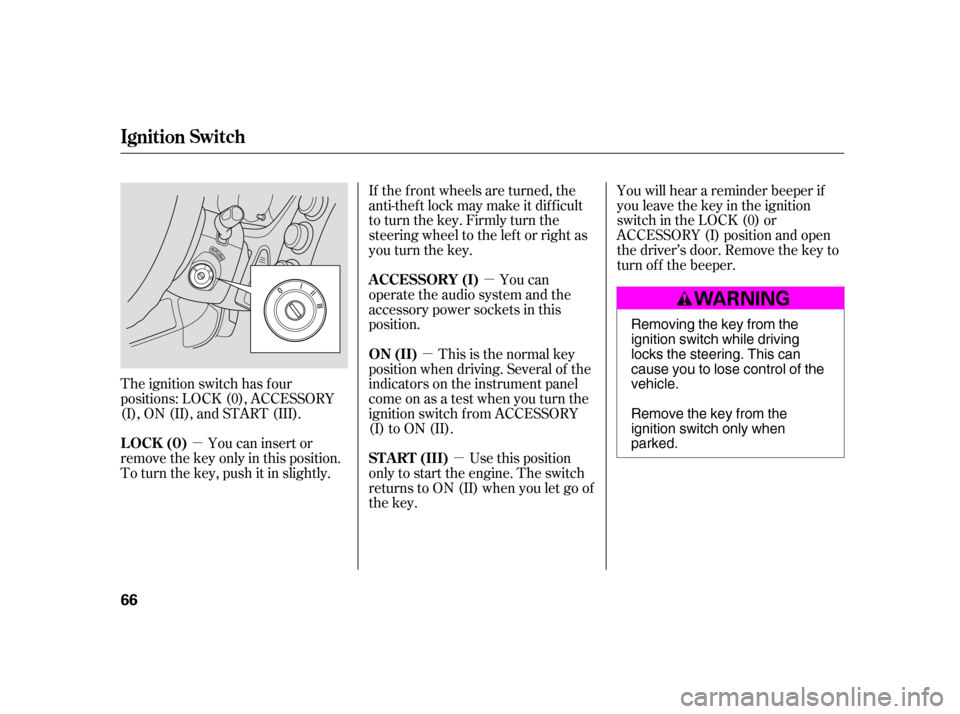Page 1 of 205
Your Vehicle at a Glance
4POWER DOOR LOCK
SWITCH
AIRBAGS
POWER WINDOW
SWITCHES HOOD RELEASE
HANDLE
FUEL FILL
DOOR RELEASE HEATING/
COOLING CONTROLS M/TAUDIO SYSTEM
GAUGES
INSTRUMENT PANEL (P. 51)
(P. 57)
(P. 67)
(P. 76) (P. 112)
(P. 111) (P. 86) (P. 90)
(P. 124)
(P. 11, 23)
�����—�����—�
���y�
�������������y���
�(���)�������y���������y
Page 8 of 205

The rest of this section gives more
detailed inf ormation about how you
can maximize your saf ety.
Remember however, that no saf ety
system can prevent all injures or
deaths that can occur in a severe
crash, even where seat belts are
properly worn and the airbags deploy.Af ter everyone has entered the
vehicle, be sure the doors are closed
and locked.
Locking the doors also helps prevent
an outsider f rom unexpectedly
opening a door when you come to a
stop.
See page f or how to lock the
doors.
If you sit too close to the steering
wheel or dashboard, you can be
seriously injured by an inf lating f ront
airbag, or by striking the steering
wheel or dashboard.
Locking the doors reduces the
chance of someone being thrown out
of the vehicle during a crash and it
helps prevent passenger f rom
accidentally opening a door and
f alling out.
Adjust the driver’s seat as far to the
rear as possible while allowing you to
maintain control of the vehicle. Have
a f ront passenger adjust their seat as
far to the rear as possible.
The f ollowing pages provide
instructions on how to properly
protect the driver, adult passengers
and teenage children who are large
enough and mature enough to ride in
the front seat.
See page f or important guidelines
on how to properly protect inf ants,
small children, and larger children
who ride in your vehicle.
30
67
Close and L ock the Doors A djust the Front Seats
Introduction 1.
2.
Protecting A dults and Teens
12
�����—�����—�
���y�
�������������y���
�(���)�������y�����
���y
Page 15 of 205

If your
hands or arms are close to an
airbag cover, they could be injured
if the airbag inf lates.
Carrying hard or sharp
objects on your lap, or driving with
a pipe or other sharp object in
your mouth, can result in injuries
if your f ront airbag inf lates.
Objects on
the covers marked ‘‘SRS AIRBAG’’
could interf ere with the proper
operation of the airbags or be
propelled inside the vehicle and
hurt someone if the airbags inf late.
If they do, they
could be very seriously injured in a
crash. If a side airbag
inflates,acupholderorotherhard
object attached on or near the
door could be propelled inside the
vehicle and hurt someone.
All passengers
must sit in locked, upright seats
andbeproperlyrestrainedbyseat
belts. Devices intended to improve
occupant comf ort or reposition the
shoulder part of a seat belt can
reduce the protective capability of
thebeltandincreasethechanceof
serious injury in a crash.
K eep your hands and arms away
f rom t he airbag covers.
Do not place hard or sharp object s
bet ween yourself and a f rontairbag.
Do not at t ach or place object s onthe f ront airbag covers.
T wo people should never use t he
same seat belt . On models wit h side airbags, do
not at t ach hard object s on or neara f ront door.
Never let passengers ride in t he cargo area or on t op of a f olded-down back seat .
Do not put any accessories on seat
belts.
Additional Saf ety Precautions
Protecting A dults and Teens
Driver and Passenger Saf ety
19
�����—�����—�
���y�
���������
���y���
�(���)�������y���������y
Page 16 of 205

Your seat belt system includes lap/
shoulder belts in all f ive seating
positions. The f ront seat belts are
also equipped with automatic seat
belt tensioners. To f asten the belt, insert the latchplate into the buckle, then tug on the
belt to make sure the buckle is
latched (see page f or how to
properly position the belt).
To unlock the belt, push the red
PRESSbuttononthebuckle.Guide
the belt across your body so that it
retracts completely. Af ter exiting the
vehicle, be sure the belt is out of the
way and will not get closed in the
door.All seat belts have an emergency
locking retractor. In normal driving,
the retractor lets you move f reely in
your seat while it keeps some
tension on the belt. During a collision
or sudden stop, the retractor
automatically locks the belt to help
restrain your body.
The seat belts in all positions except
the driver’s have an additional
locking mechanism that must be
activated to secure a child seat (see
page ).
If the shoulder part of the belt is
pulled all the way out, the locking
mechanism will activate. The belt
will retract, but it will not allow the
passenger to move f reely.
The seat belt system
includes an indicator on the
instrument panel and a beeper to
remind you and your passengers to
f asten your seat belts.
If you turn the ignition switch to ON
(II) bef ore f astening your belt, the
beeper sounds and the indicator
f lashes. If you do not f asten your
seat belt bef ore the beeper stops, the
indicator stops f lashing but remainson.
If you continue driving without
f astening your seat belt, the beeper
will sound and the indicator will f lash
again at regular intervals. The lap/shoulder belt goes over
your shoulder, across your chest,
and across your hips.
40
15
Seat Belt System Components L ap/Shoulder Belt
Additional Inf ormation About Your Seat Belts
20
�����—�����—�
���y�
�������������y���
�(���)�������y���������y
Page 29 of 205

�µ
If they do, they
could be very seriously injured in a
crash. During a crash, the
belt could press deep into the child
and cause serious or fatal injuries. Children who play in vehicles can
accidentally get trapped inside.
Teach your children not to play in
or around vehicles. Even very young
children learn how to unlock
vehicle doors, turn on the ignition
switch, and open the hatch, which
can lead to accidental injury or
death.
If you are not wearing a
seat belt in a crash, you could be
thrown f orward and crush the
child against the dashboard or a
seat-back. If you are wearing a
seat belt the child can be torn
from your arms and be seriously
hurt or killed. Leaving children without
adult supervision is illegal in most
states and Canadian provinces,
and can be very hazardous.
For example, infants and small
childrenleftinavehicleonahot
day can die f rom heatstroke. A
child lef t alone with the key in the
ignition can accidentally set the
vehicle in motion, possibly injuring
themselves or others.
Additional Saf ety Precautions
Never let two children use the
same seat belt .
Never put a seat belt over yourself
and a child. Lock both doors and the hatchwhen your vehicle is not in use. K eep vehicle keys and remot e
transmitters out of reach ofchildren.
Neverholdaninfantorchildon
your lap. Do not leave children alone in a
vehicle.
Protecting Children General Guidelines
Driver and Passenger Saf ety
33
�����—�����—�
���y�
������
������y���
�(���)�������y���������y
Page 45 of 205
Control L ocations
50MIRROR CONTROLS
POWER DOOR LOCK
SWITCH
POWER WINDOW
SWITCHES
FUEL FILL DOOR
RELEASE
HOOD RELEASE HANDLE M/T
HEATING/COOLING CONTROLS
AUDIO SYSTEM
GAUGES
INSTRUMENT PANEL
(P. 51)
(P. 57)
(P. 79)
(P. 67)
(P. 76)
(P. 111) (P. 90)
(P. 86)
(P. 112) ACCESSORY POWER
SOCKET(P. 124)
(P. 83)
�����—�����—�
���y�
�������������y���
�(���)�������y���������y
Page 59 of 205
The master key fits all the locks on
your vehicle.
The valet key works only in the
ignition, the door locks and hatch.Youshouldhavereceivedakey
number tag with your keys. You will
need this key number if you ever
have to get a lost key replaced. Use
only Honda-approved key blanks.
These keys contain electronic
circuits that are activated by the
Immobilizer System. They will not
work to start the engine if the
circuits are damaged.
Protect the keys f rom direct
sunlight, high temperature, and
high humidity.
Donotdropthekeysorsetheavy
objects on them.
Keep the keys away f rom liquids.
If they get wet, dry them
immediately with a sof t cloth.
The keys do not contain batteries.
Do not try to take them apart.
Keys and Locks
64 KEY
NUMBERTAG
MASTER
KEYS
(Black) VALET
KEY
(Gray)
�����—�����—�
���y�
���������
���y���
�(���)�������y���������y
Page 61 of 205

�µ
�µ
�µ �µ
The ignition switch has f our
positions: LOCK (0), ACCESSORY
(I), ON (II), and START (III). If the f ront wheels are turned, the
anti-thef t lock may make it dif f icult
to turn the key. Firmly turn the
steering wheel to the lef t or right as
you turn the key.
You can
operate the audio system and the
accessory power sockets in this
position.
Use this position
only to start the engine. The switch
returns to ON (II) when you let go of
the key. You will hear a reminder beeper if
you leave the key in the ignition
switch in the LOCK (0) or
ACCESSORY (I) position and open
thedriver’sdoor.Removethekeyto
turn of f the beeper.
You can insert or
remove the key only in this position.
To turn the key, push it in slightly. This is the normal key
position when driving. Several of the
indicators on the instrument panel
come on as a test when you turn the
ignition switch f rom ACCESSORY
(I) to ON (II).
A CCESSORY (I)
ST A RT (III)
LOCK (0) ON (II)
Ignition Switch
66 Removing the key from the
ignition switch while driving
locks the steering. This can
cause you to lose control of thevehicle.
Remove the key from the
ignition switch only whenparked.
�����—�����—�
���y�
�������������y���
�(���)�������y���������y